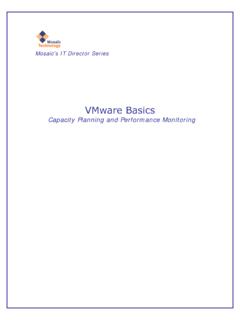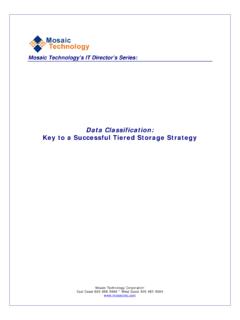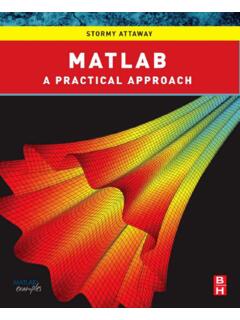Transcription of iSCSI Basics: A Practical Introduction - Mosaic Technology
1 Mosaic IT Directors Series iSCSI basics : A Practical Introduction iSCSI basics : A Practical Introduction 2 iSCSI basics : A Practical Introduction Table of Contents Overview _____ 3 Internet SCSI _____ 3 SCSI _____ 4 Fibre Channel/SAN _____ 4 NAS _____ 4 How iSCSI Works _____ 5 iSCSI in the Enterprise _____ 6 Where iSCSI Fits In The Enterprise _____ 7 Why iSCSI ?_____ 8 About Mosaic Technology _____ 9 iSCSI basics : A Practical Introduction 3 iSCSI basics : A Practical Introduction Overview Over the last two decades, computers evolved from simple productivity tools into the core infrastructure of the entire global economy.
2 That rise to prominence is reflected in the increasing focus of IT in all business processes and in evolving oversight regulatory mandates which require stringent controls around data handling and access. Business information and data repositories have become indispensable to the success of any business. Today, workers require information access in order to do their jobs effectively. As a result, the need to provide access to a dramatically increasing information/data set is an essential element of corporate planning and long-term success. Storage sits at the center of information access. It has gotten faster, smaller, and -- on a gigabyte basis cheaper. It has also evolved into a major management challenge in terms of building effective and efficient (cost and performance) storage systems.
3 - In response to this challenge Technology evolved from SCSI to NASs and SANs. Now iSCSI offers an additional storage option. One that promises simplified management and implementation at reduced costs. This guide is an Introduction to iSCSI as a Technology and an enterprise level storage solution. Internet SCSI Internet Protocol (IP) is the most widely used standard anywhere. The Technology is well understood. It s easy to implement and is affordable. Most corporate data traffic uses a common IP for storage data. Access to high performance storage data traditionally requires direct-attached devices or a Fibre Channel (FC) storage network. Internet SCSI ( iSCSI ) transports traditional high performance block-based storage data over a common IP network.
4 Which means - it can be used in remote mirroring, remote backup and similar applications since an IP network has no distance limitations. iSCSI basics : A Practical Introduction 4 As iSCSI begins to achieve widespread market adoption, barriers to implementing and managing networked storage can be removed by incorporating IP networking into a storage network. SCSI Most servers access storage devices through the Small Computer Systems Interface (SCSI) standard, moving blocks of data among computer systems. But its limitations became clear as demand for storage capacity grew. SCSI s built-in limitations on distance, number of devices supported and exclusive ownership of a server to its respective SCSI storage device prohibited the creation and sharing of a common pool of storage.
5 Fibre Channel/SAN Creating a shared storage environment is best done with networked storage. Fibre Channel (FC) is the basis for building a Storage Area Network (SAN) and popular because it offers: high performance, support for longer distances than SCSI, ability to transport block-level data, and capability to scale to large network configurations. Although no longer proprietary, FC based storage networks do have some baggage: complexity, cost difficult to install and manage. NAS Another method of networking storage is to attach the storage device directly to an existing Ethernet network in a Network Attached Storage (NAS) configuration. NAS is typically a simpler and lower cost than a SAN.
6 It leverages the benefits of using an IP network, such as support for significantly longer distances. However, NAS is slower than FC SAN. Data transport is managed at file level not the block level. This significantly slows data access in transactional or database applications. Issues of scalability, centralization and management of a single pool of storage increase as the number of NAS systems deployed in a site increases. A new solution was needed that offered the low cost and ease of deployment of NAS systems and the functionality of SAN. That s where iSCSI plays. iSCSI basics : A Practical Introduction 5 How iSCSI Works Internet SCSI ( iSCSI ) enables server host applications to perform traditional block-level transactions over a common IP network.
7 It s built on two of the most commonly understood protocols: SCSI and Ethernet, the dominant standards for storage and networking. Using an ordinary IP network, iSCSI transports block-level data between an iSCSI initiator on a server and an iSCSI target on a storage device. The iSCSI protocol encapsulates SCSI commands and assembles the data in packets for the TCP/IP layer. Packets are sent over the network using a point-to-point connection. Upon arrival, the protocol translates data back to SCSI. Security is provided through iSCSI authentication and virtual private networks (VPNs), as needed. When an iSCSI initiator connects to an iSCSI target, the operating system sees the storage as a local SCSI device that can be formatted as usual.
8 The process is transparent to applications, file systems, and operating systems. By consolidating storage with an iSCSI SAN, different platforms can share the same storage, greatly improving utilization and efficiency. Multi-protocol switches let iSCSI and Fibre Channel SANs co-exist To access iSCSI storage, a server needs an iSCSI initiator connected to a network. An initiator can be an iSCSI driver with a standard network card, or a card with a TCP offload engine (TOE) to reduce CPU utilization. HBAs are available that offload both TCP and iSCSI . On the target side, storage devices also implement the iSCSI protocol stack. Communication between computing and storage platforms with iSCSI iSCSI processing can be off-loaded to dedicated intelligent HBAs.
9 iSCSI basics : A Practical Introduction 6 With the advent of Gigabit Ethernet, iSCSI can deliver performance approaching a Fibre Channel SAN. Recent advances in 10GB Ethernet promise to make iSCSI a high performance solution capable of meeting and or exceeding other storage solutions performance levels. The primary benefits of iSCSI leveraging IP are clear: no distance limitation lower cost well understood Technology easy to administer and manage high availability (multiple connection paths) better performance than NAS (block level access instead of file level) maximum utilization of resources (share disk and tape devices across a heterogeneous environment).
10 FC SANs may be faster and have greater adoption and more robust management tools than iSCSI offers today. But, IP SANs are simpler and more affordable to implement than traditional FC SANs. And, with the 10 GbE, iSCSI on the horizon, IP SANs will benefit from the faster transfer rates. But iSCSI need not replace FC to fit in the enterprise. iSCSI in the Enterprise It would be prohibitively expensive to maintain all company data on instantly available and immediately recoverable storage systems. Enterprises routinely move less critical data to less available storage or archive it offline. But business and regulatory compliance requirements are beginning to demand rapid access to some of these archived records, which are no longer on immediately available storage.













